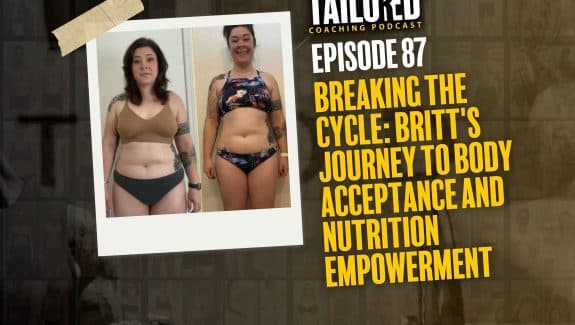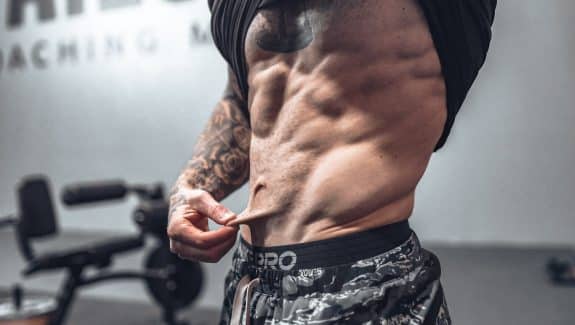Every single month, our Chief Science Officer Dr. Brandon Roberts puts together a Research Review with 2-3 top studies on specific topics catered to our audiences’ goals, questions, and struggles.
In this month’s edition, we decided to change things up a bit and instead of reviewing a specific study – we decided to answer specific questions, USING the top research studies to back up our answers, strategies, and recommendations. The result was better than we expected and we came up with a Q&A style podcast and blog that is more easily digestible for the reader and more applicable for the every-day individual just trying to look better, be healthier, and lift heavier!
Before we dive into the written version of this Research Review Q&A, you can listen to the episode if you’d like on iTunes, Spotify, Stitcher, and everywhere else Podcasts are hosted OR simply listen on the player below:
1.) Is It Scientifically Possible To Gain Muscle and Lose Fat? (i.e. Body Recomposition)
Body recomposition is simultaneously losing fat and gaining muscle at the same time. This usually results in minimal or no weight change on the scale, so it often confuses people, but it makes for great transformation pictures. The problem with body recomposition is that it is seldom directly studied in research. There are tons of studies on how to lose weight or how to optimize training or nutrition to enhance muscle growth. However, in research we power our studies on the primary outcome, which is usually to lose weight or increase muscle size. In order to find differences between groups we want to statistically power the studies on the most relevant (and robust) outcome. In that case it’s often either weight loss or muscle gain. So in order to understand body recomposition we have to squint a little when interpreting the research.
Body recomposition mainly occurs in newbies or those coming back to training after a long break. It can occur in intermediate athletes, but focusing on short-term body recomp may not be the best use of their time. This is due to the underlying processes that occur: muscle protein synthesis (MPS) and carbohydrate/lipid oxidation. When we strength train we increase MPS. We can increase MPS even more by consuming protein. Over time these MPS changes accumulate and we gain muscle size. Simply put, newbies gain more muscle because they are adapting to a novel stimulus. It is also well-known (though not researched much) that we gain the most muscle mass during our first year of training and it slowly decreases each year we train. If you’re not training properly then you can stay in the intermediate phase of your training for a long time and may see a small bump once you switch to an optimized program or when being coached.
The other component of body recomposition is fat loss. Fat loss usually occurs when we are in a prolonged energy deficit. Yet, we aren’t in a complete deficit every single hour of a diet, much like MPS, we go through phases of positive and negative energy balance. When we lose fat we just happen to be in a negative phase for longer periods.
Fat is primarily stored in designated fat storage cells known as adipocytes. Depending on the energy phase, adipocytes can take up and store fat from the blood or release fat back to the blood for us to burn for energy. Fat can be stored within the muscle as intramuscular triglycerides, but as an adipocyte it is a completely different cell type, so it can be regulated differently. When we’re in a deficit we release energy from fat to compensate for our lack of energy intake. This creates a smaller adipocyte. If you’re in an energy deficit for a long period because you never eat enough to refill that adipocyte, it slowly shrinks (fat loss). Meanwhile, in the muscle cells, we’re still having to adapt to the stress of resistance training to repair and remodel muscle to better handle the stimulus of training. This plays out well in small deficits (100-250kcal) where we aren’t in a deficit very much during the course of a day.To use muscle for fuel we need to either be in a very steep deficit or be extremely lean. That’s because the conversion of protein in muscle to energy is extremely inefficient. It’s also the reason we see with high protein diets ⸺ we’re giving out muscles the fuel they need to grow but not refilling our fat cells.
If you want to read more on body recomposition in trained people check out this article. Then head over to my instagram and read the series on the studies covered in the article to see a more thorough breakdown of the research. The evidence is murky at best.
2.) Is It Better To Do Cardio Before or After Your Workout?
Cardio is an excellent tool for losing weight. However, there is a limit to how much weight we can lose with cardio alone. This is due to the constrained energy model. Weight loss from exercise peaks at about ~5-7lbs due to adaptations that occur with non-exercise activity and adaptations to exercise. We become efficient at burning energy while exercising so in order to avoid overuse injuries and other detrimental effects we have to decrease our food intake.
When it comes to doing cardio pre or post training it depends on your goal. If your goal is to maximize muscle size or strength then you’ll want to do it on a completely different day than your weight training. That’s not always feasible, so if you’re crunched for time you would want to do cardio before your training if you are focused on improving aerobic or endurance performance, but after weight training if you’re focused on strength or hypertrophy goals. The main reason for this is fatigue. We want to do the exercises that we want to improve the most first before we’re too tired. This allows us to lift more weight or run faster, thus improving performance faster.
3.) Should You Be Doing A “Reverse Diet” Or A “Recovery Diet”?
The terms reverse diet and recovery diet are often confused. They are somewhat referenced in the literature on metabolic adaptation and physique athletes. The terms were made popular by 3DMJ in relation to recovery from contest preparation. Since then, the idea of a reverse diet has subtly changed. Since most people aren’t physique competitors, we’ll focus on how reverse dieting can be used to return to maintenance calories or increase your maintenance caloric intake. Then we’ll cover the recovery diet.
If you’ve been dieting for more than a few weeks your body has likely adapted by decreasing your basal metabolic rate and your non-exercise activity thermogenesis (NEAT). This is a good thing for survival. It’s not a good thing if you’re trying to lose weight. To reverse out of a diet (aka reverse diet) we can either make large jumps in calories or small jumps. The risk with small increases in calories is being in a prolonged deficit and the risk with large increases is overshooting your maintenance leading to an unwanted increase in fat mass. We also have to be aware that your metabolism and your NEAT are going to adapt as we increase calories, so this is best done with 50-200 kcal increases per week over an extended period of time (4+ weeks) with the goal of stopping and maintaining your intake once you gain more than a pound or two. The rationale for allowing for some weight gain is due to the increases in gut content from eating more food, the sodium/water that comes with the extra food, and the increase in glycogen stores from increasing your calories. Practically, this means you’ll increase your calories for a period of time with a slight increase in body weight, then once you’ve levelled out you would pause to see if that weight changes, then make adjustments as needed.
Your metabolism and NEAT can also increase when we’re overeating so we can use this as a tool to increase your “maintenance” calories independent of reversing from a diet. The magnitude of the increase varies, but is usually in the range of 100-400 kcals. What we’re doing is increasing your calories to the point where you’re moving more and fueling your performance, but not gaining fat. If we push calories too high we’ll end up in a surplus which may not be your goal. This can be done in a similar manner to reversing from a diet by slowly increasing your calories with very minimal weight gain (due to food content). In practice, you often have to overshoot your maintenance to find the number of calories you can eat to maintain your body weight, then reduce your calories so that you’re not gaining weight. It can be very tricky.
Recovery diets are a different beast. In a recovery diet your body is physiologically in a terrible place because you’re extremely lean. That’s why we don’t want to stay too lean for too long. The goal of a recovery diet is to increase calories quickly and by a large amount to return your body to a healthy state. When you’re extremely lean you have high ghrelin, low leptin, and low testosterone (or estrogen), which isn’t good for your long-term health. We want that to change as quickly as we can so we don’t care if we gain fat. In fact, we probably want to gain a substantial amount of fat so our bodies aren’t freaking out.
4.) What’s Most Important For Maintaining Muscle Mass and Strength During A Cut, Intensity or Volume?
Maintaining your muscle size and strength takes much less work than building it. When faced with the choice of reducing intensity or volume it’s important to consider a few factors including the amount of time you’re going to spend at maintenance, nutrition intake, training frequency, and your main training goal.
If your goal is to maintain muscle strength, then you should likely decrease volume, but keep intensity high. This is because the neural adaptations that occur with strength training are some of the first changes to reverse. They don’t reverse completely, but if you’ve ever taken some time away from the gym the bar feels a lot heavier than when you left it. From a research perspective, we only have a few studies that are semi-relevant. An old study by Morehouse trained participants isometrically for 9 weeks at 100% of their maximal voluntary contraction, then reduced frequency, volume, and intensity by 50% for eight weeks. The participants were unable to maintain their strength, indicating that we can’t reduce intensity too much for too long or we’ll start losing strength.
Unfortunately, no research has ever isolated the independent effect of reduced volume on muscle strength and size. That said, there are two studies which shed some light on the topic. This study, from the place I did my postdoctoral fellowship, investigated the effect of reduced exercise frequency and volume on strength and muscle size. The authors reduced exercise frequency from 3 sessions per week to 1 session per week, and exercise volume from 3 sets per exercise to 1 set per exercise for 32 weeks of training whereas exercise intensity remained the same (8–12RM). These researchers found further improvements in 1RM strength during the reduced training period; in addition, muscle size was fully maintained in younger, but not older (60-75y) participants. An important limitation to this study is that it was completed on untrained participants. Another study reduced exercise frequency from 2-3 sessions per week to 1 or 2 sessions per week, and kept intensity the same (6-12RM). They found that strength and muscle size were fully maintained for eight weeks after the initial training period of 16 weeks. This study was also on untrained participants.
From a practical standpoint, if you plan to spend a long time at maintenance you’ll want to keep your training volume at about 60-80% of what you would do to try to add strength and size. For example, if you are accustomed to doing chest twice per week for 10 sets at 8-12RM then you would want to stay between 6-8 sets and keep training twice per week and keep intensity the same. As an alternative you could switch to thrice per week training and do 2 sets, which might allow you to train more muscle groups in a single training session.
If you’re dieting there is a higher chance you lose both muscle size and strength if you reduce your intensity, even if you consume plenty of protein (1.8-2.2g/kg bodyweight/day), so I would recommend not spending too much time at a reduced training intensity while dieting.

5.) Is Compression Therapy Effective?
The current evidence suggests that compression garments are effective in enhancing recovery from exercise-induced muscle damage (EIMD). However, this may not be applicable to athletes since a lot of EIMD studies use extreme eccentric protocols to elicit muscle damage. One of the better studies to date was a meta-analysis which found lower-limb compression garments are not associated with improved performance in the vertical jump, VO2 max, or RPE during exercise.
The influence of technology, such as the Normatec systems, has created a renewed buzz around compression therapy. There are even a few studies using the exact Normatec device. For example, Haun et al., compared the effects of Normatec vs sham when used concurrently with resistance training on performance-related outcomes and molecular measures related to recovery. They found that the Normatec device reduces muscle soreness and attenuated reductions in flexibility, although they did not identify any molecular mechanisms causing these beneficial changes. Other studies have found that compression treatment with the Normatec can rapidly enhance acute range of motion with less discomfort and in less time than a control condition. Another study from the same group found that the Normatec device can improve the short-term pressure-to-pain threshold in Olympic athletes, and speculated that it could improve recovery.
To answer the question bluntly: I think compression therapy could be useful if you struggle to recover, but likely isn’t necessary for the general population or aspiring physique athletes.
























































































































































































































































































































































































































































































